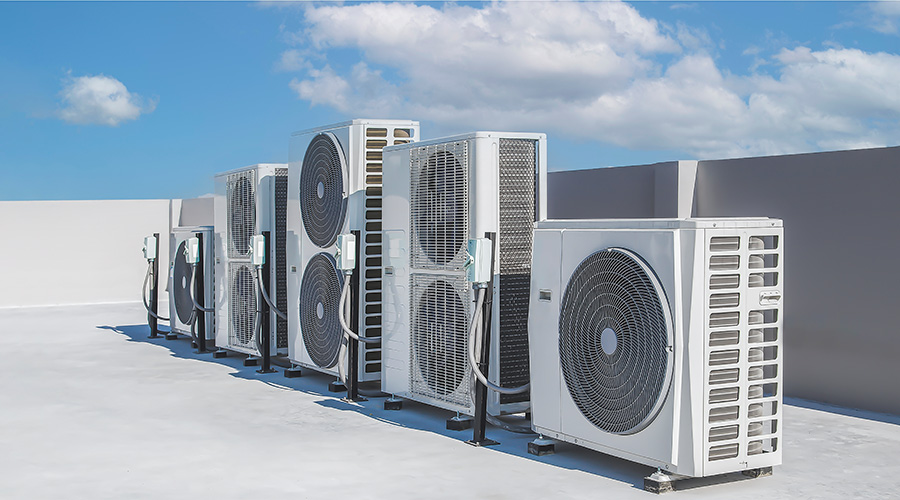Water Treatment as Insurance
A comprehensive program can enhance system efficiency, help control utility costs and extend the life of key systems and components
Water treatment can be a mystery, and the old adage, “Out of sight, out of mind,” is too often the philosophy of many building owners. This attitude arises in part because the inside of the equipment and piping infrastructure cannot be easily seen or inspected.
There also are many examples of less-than-scrupulous water-treatment companies selling expensive or ineffective water-treatment chemicals and equipment, which also might discourage maintenance and engineering managers from developing an effective water-treatment program.
Water treatment is the best insurance for protecting major investments in a building’s heating and cooling infrastructure. Left untreated, water systems can quickly cause damage.
A successful water-treatment program for HVAC and potable-water systems is mandatory to maintain the energy efficiency of equipment in like-new condition, guard the equipment from scale and corrosion, and protect building occupants.
Industry Evolution
The water-treatment industry has changed significantly in the last 15 years as companies have sought immediate profit gains through mergers and acquisitions. Now, about six major water-treatment companies serve customers throughout the United States.
Environmental regulations also have changed the technology used in the water-treatment industry. Cooling-tower systems now use phosphates and molbydates versus chromate-based inhibitors, which were popular in the past for scale and corrosion control.
Recent outbreaks of Legionella also have raised the level of scrutiny of water-treatment solutions for potable-water systems, spas, whirlpools, cooling towers, storage tanks and other parts of systems susceptible to growing and breeding the bacteria.
Starting a Program
Many institutional and commercial facilities have realized that developing a relationship with a water-treatment company is just as important as the water-treatment technology itself. Selecting a reputable and reliable water-treatment company is crucial.
Maintenance and engineering managers should view the relationship as a partnership, where they can openly discuss and review new water-treatment technologies to decide which is appropriate for their facilities. Managers view some new water-treatment technologies in the same light as snake oil, but with a true partnership, they can avoid potential disasters from the latest and greatest ideas.
After selecting a water-treatment company, the next step is a raw water analysis. This step is necessary to design the chemical program appropriate for each building.
By conducting the raw-water analysis and determining a system’s operating hours, load factor and operating temperature, a water-treatment specialist can determine the equipment, chemicals and monitoring required for a successful water-treatment program. It is not a good idea to base a building’s chemical treatment on a neighboring facility's program, since local water sources can vary, operating hours are different, and equipment is designed specifically for each building.
The major systems in buildings that require water treatment are cooling towers, condenser-water systems, steam systems, closed systems for chilled water and hot water, and potable-water systems. Managers must design a water-treatment program for each system.
Cooling Towers and Condenser-water Systems
The major components in a condenser-water system are cooling towers, water chillers, pumps and piping. The system rejects heat from the system via the cooling tower. Circulating water across the cooling tower cools it by evaporation, and it returns it to the chiller.
Condenser-water systems are open, and as water cools, impurities in the water concentrate. This process leads to potential scale and corrosion of the metals in chillers and cooling towers.
Controlling scale and corrosion is a major treatment required so that all condensing-water systems can maintain chiller efficiencies and prolong equipment life. Traditional equipment needed to control scale and corrosion in a cooling tower system includes a conductivity controller, a chemical-feed pump and controller, a water meter on cooling tower make-up, a blow-down solenoid valve, and a corrosion coupon rack.
In cooling-tower systems, four primary factors — pH, temperature, hardness and alkalinity — determine the appropriate amount of chemicals to use and the amount of water to bleed from the system. By verifying these factors, managers can establish the proper water-treatment program to protect the equipment and maintain efficiency.
Setting up the proper program significantly reduces treatment and makeup water costs. Makeup water for a cooling-tower system is usually 2-3 percent of the system's circulation rate. For a 1,000-ton system, the makeup rate is 60-90 gallons per minute (gpm) of makeup water. If the makeup is metered, most water departments allow a credit for sewer charges. This is a significant operating cost, so it is worth the effort to set up a treatment program properly.
Another major source of contamination in a condenser-water system is growth of biological organisms. Two methods can help control biological growth in condenser-water systems — biocides and ozone.
Using biocides is the more traditional approach and usually involves two or more chemicals alternately injected into the system. This process requires feed equipment to introduce the biocides automatically.
Ozone generation in cooling-tower systems continues to surface as a viable treatment option to replace chemicals for biological and scale control and reduce water makeup. Ozone is an excellent biocide, but there are many examples of misapplied ozone systems on cooling towers, resulting in expensive repairs to chillers and cooling towers.
For certain applications, ozone generation might be successful when administered properly. Maintenance managers should thoroughly research this option before implementation or discuss it with their water-treatment specialist.
Managers can expect treatment costs for a 1,000-ton cooling-water system to be $10 per ton per year or $5,000 per year. Condenser-tube fouling can significantly increase energy cost. A film thickness of 0.0005 inch will increase energy use by 4 percent, while a film thickness of 0.003 inch increases energy use by more than 22 percent. Clearly, spending $5,000 per year on treatment is a smart purchase.
Steam Systems
Steam systems consist of boilers, steam piping, condensate piping and boiler-feed equipment. Major factors in establishing a treatment program include raw-water analysis, operating pressure, load factor, and percentage of returned condensate. Treatment includes steam-line treatment, scale and corrosion inhibitors, and an oxygen scavenger.
In recent years, concern has risen over using direct-steam humidification in concert with amines for steam-line treatment. Once amines are dispersed into the air, they can cause problems for building occupants susceptible to respiratory problems.
The current practice is to use steam-to-steam heat exchangers or other humidification methods to avoid direct-steam humidification. Managers should review this issue with a water-treatment specialist and other consultants to determine the optimum solution that ensures occupant safety. Typical costs for water treatment of a steam boiler system is $10 per year per boiler horsepower (bhp) or $5,000 per year for a 500 bhp boiler plant. Boiler energy costs can increase 25 percent per month if the tubes are scaled, even by a small amount.
Potable Water and legionella
Legionella — legionella pneumphila — is a bacteria that was discovered in 1976 at an American Legion convention in Philadelphia. Investigators originally believed that an abandoned cooling tower was its source, but recent research indicates that the Legionella might have been introduced through a potable-water system.
While Legionella are relatively resistant to standard water-disinfection procedures, research has produced very effective means to control and prevent it in potable-water systems.
Control methods designed to disinfect an entire water distribution system include:
-
thermal flush at a minimum of 1,400 degrees
-
copper-sliver ionization
-
hyperchlorination.
Control methods that are designed to disinfect only a specific portion of a water-distribution system include:
-
ultraviolet-light sterilization
-
ozonation
-
instant steam heating.
Selecting one or a combination of these two types of control methods is best for eradicating Legionella colonies and preventing re-colonization of the water-distribution system.
|
Water Treatment as a Specialty
Managers seeking to improve water quality might consider making such responsibilities part of a more comprehensive system of specialized inspections and checks. Some departments assign certain pieces of equipment to an area maintenance inspector who is familiar with that system and equipment.
For example, a trained and experienced inspector might be assigned to inspect and treat a facility’s cooling-water system by using a checklist, taking water samples, and recording equipment conditions and variables.
The inspector can note and correct deficiencies in equipment condition when they are minor. The inspector also can adjust water quality on the run — that is, make a second round at the end of the shift to perform water treatment as prescribed in order to adjust the chemical makeup.
This specialized approach can prevent problems, such as scale buildup in cooling-system piping and in operating equipment. It also can prevent slime and algae formation in cooling towers.
A water-treatment vendor can provide the appropriate chemical composition and treatment routine for boiler feedwater, steam and steam condensate, and waste water. The vendor’s representative can visit the facility, take samples and have them analyzed at a laboratory. The vendor also can furnish a report, provide an analysis of the water and recommend treatment and using their chemicals.
An alternate approach is to send the water samples to an independent testing laboratory for analysis and treatment recommendations. Of course, there is a fee for this service. While the vendor service is free, the cost of the analysis is included in the cost of the chemicals purchased from the company.
|
Related Topics:











